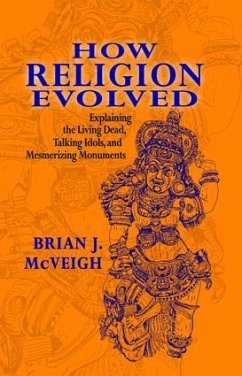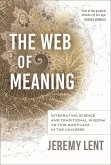Brian McVeigh
How Religion Evolved
Explaining the Living Dead, Talking Idols, and Mesmerizing Monuments
Brian McVeigh
How Religion Evolved
Explaining the Living Dead, Talking Idols, and Mesmerizing Monuments
- Gebundenes Buch
- Merkliste
- Auf die Merkliste
- Bewerten Bewerten
- Teilen
- Produkt teilen
- Produkterinnerung
- Produkterinnerung
Why did many religious leadersâ Moses, Old Testament prophets, Zoroasterâ claim they heard divine voices? Why do ancient civilizations exhibit key similarities, e
Andere Kunden interessierten sich auch für
![Excluding the Jew Within Us Excluding the Jew Within Us]() Jean-Luc NancyExcluding the Jew Within Us12,99 €
Jean-Luc NancyExcluding the Jew Within Us12,99 €![Critique of Black Reason Critique of Black Reason]() Achille MbembeCritique of Black Reason31,99 €
Achille MbembeCritique of Black Reason31,99 €![The Web of Meaning The Web of Meaning]() Jeremy LentThe Web of Meaning26,99 €
Jeremy LentThe Web of Meaning26,99 €![The Genesis of Modernity The Genesis of Modernity]() Arpad SzakolczaiThe Genesis of Modernity63,99 €
Arpad SzakolczaiThe Genesis of Modernity63,99 €![Living in a World That Can't Be Fixed: Reimagining Counterculture Today Living in a World That Can't Be Fixed: Reimagining Counterculture Today]() Curtis WhiteLiving in a World That Can't Be Fixed: Reimagining Counterculture Today16,99 €
Curtis WhiteLiving in a World That Can't Be Fixed: Reimagining Counterculture Today16,99 €![In-Between Worlds In-Between Worlds]() Sukanya ChakrabartiIn-Between Worlds132,99 €
Sukanya ChakrabartiIn-Between Worlds132,99 €![The Case for Rage The Case for Rage]() Myisha Cherry (Assistant Profess Assistant Professor of PhilosophyThe Case for Rage31,99 €
Myisha Cherry (Assistant Profess Assistant Professor of PhilosophyThe Case for Rage31,99 €-
-
-
Why did many religious leadersâ Moses, Old Testament prophets, Zoroasterâ claim they heard divine voices? Why do ancient civilizations exhibit key similarities, e
Hinweis: Dieser Artikel kann nur an eine deutsche Lieferadresse ausgeliefert werden.
Hinweis: Dieser Artikel kann nur an eine deutsche Lieferadresse ausgeliefert werden.
Produktdetails
- Produktdetails
- Verlag: Taylor & Francis Inc
- Seitenzahl: 310
- Erscheinungstermin: 30. Juli 2016
- Englisch
- Abmessung: 231mm x 155mm x 23mm
- Gewicht: 550g
- ISBN-13: 9781412862868
- ISBN-10: 1412862868
- Artikelnr.: 44316812
- Herstellerkennzeichnung
- Libri GmbH
- Europaallee 1
- 36244 Bad Hersfeld
- gpsr@libri.de
- Verlag: Taylor & Francis Inc
- Seitenzahl: 310
- Erscheinungstermin: 30. Juli 2016
- Englisch
- Abmessung: 231mm x 155mm x 23mm
- Gewicht: 550g
- ISBN-13: 9781412862868
- ISBN-10: 1412862868
- Artikelnr.: 44316812
- Herstellerkennzeichnung
- Libri GmbH
- Europaallee 1
- 36244 Bad Hersfeld
- gpsr@libri.de
Brian McVeigh
Contents
Foreword by Marcel Kuijsten
Acknowledgments
Prologue: Chasing Ghosts in Tokyo
Part I: The World According to the Gods
1 The Failure of Science to Explain Religion
2 Why the Gods Began to Speak
3 Divine Voices and Visions as Social Adaptation
Part II: When the Gods Spoke and Walked among Us
4 The Living Dead: Explaining Entombment and Ancestor Worship
5 Towns as the Domain of the Gods
6 Temples as Relay Stations: Transmitting Divine Commands
7 Talking Idols: Tools of Divine Control
8 Mortuary Monuments: How the Gods Awed Their Followers
9 Heavenly Ambassadors: God-Kings and Sacred Rulers
10 Ancient Civilizations as God-Governed
11 Mesoamerica: Theocentric Civilizations of the New World
12 Trimming the Theological Tree: Monotheism as Adaptation
13 Angels, Divine Messengers, and Swarms of Demons
Part III: When the Gods Fell Silent
14 Prayers, Possessions, and Prophecies: Conjuring Up the Missing Gods
15 The Gods Depart: The Late-Bronze-Period Dark Ages
16 A Change of Mind in the Ancient World
17 The Axial Age: The World Reborn without Gods
18 Imagining the Transcendent: A New Cognitive Ability
19 Introcosm: A New World of Space and Time
20 The Self Replaces the Gods
21 From Revelation to Reasoning
22 When the Gods Still Whisper: Strange Behaviors Explained
Epilogue: Science and Politics as Neo-Religion
Appendices and Supplementary Charts
A How to Chase Ghosts
B Explaining Religion versus Explaining Religion Away
C Gods on the Brain: Neurotheology
D The Problem with "Cultural Evolution"
E Six Hypotheses of Jaynesian Psychology
F The Limitations of Evolutionary Psychology
G Prehistoric and Historic Mentalities in Perspective
H Predictable Objections, Rebuttals, and Qualifications
I Verification and Applications of Jaynes's Theories
J Primitive Psychopolitics and Neurocultural Adaptation
K A History of Mentalities
L Population Size of Ancient Towns and Cities
M Dreams: A Form of Conscious Interiority
N Pre-Axial and Axial Ages Compared
O Solving the Mystery of Hallucinations
P Autoscopy: Seeing One's Double
Q What the Gods Can Teach Us: A New Understanding of the Mind
Timelines of Mentalities
Explanation
1 Three Major Shifts in Human Mentality
2 Prehistoric Mentalities
3 Middle East
4 Africa
5 Europe
6 South Asia
7 East Asia
8 Southeast Asia
9 Oceania
10 North America
11 South America
12 Mesoamerica
Glossary
References
Index
Foreword by Marcel Kuijsten
Acknowledgments
Prologue: Chasing Ghosts in Tokyo
Part I: The World According to the Gods
1 The Failure of Science to Explain Religion
2 Why the Gods Began to Speak
3 Divine Voices and Visions as Social Adaptation
Part II: When the Gods Spoke and Walked among Us
4 The Living Dead: Explaining Entombment and Ancestor Worship
5 Towns as the Domain of the Gods
6 Temples as Relay Stations: Transmitting Divine Commands
7 Talking Idols: Tools of Divine Control
8 Mortuary Monuments: How the Gods Awed Their Followers
9 Heavenly Ambassadors: God-Kings and Sacred Rulers
10 Ancient Civilizations as God-Governed
11 Mesoamerica: Theocentric Civilizations of the New World
12 Trimming the Theological Tree: Monotheism as Adaptation
13 Angels, Divine Messengers, and Swarms of Demons
Part III: When the Gods Fell Silent
14 Prayers, Possessions, and Prophecies: Conjuring Up the Missing Gods
15 The Gods Depart: The Late-Bronze-Period Dark Ages
16 A Change of Mind in the Ancient World
17 The Axial Age: The World Reborn without Gods
18 Imagining the Transcendent: A New Cognitive Ability
19 Introcosm: A New World of Space and Time
20 The Self Replaces the Gods
21 From Revelation to Reasoning
22 When the Gods Still Whisper: Strange Behaviors Explained
Epilogue: Science and Politics as Neo-Religion
Appendices and Supplementary Charts
A How to Chase Ghosts
B Explaining Religion versus Explaining Religion Away
C Gods on the Brain: Neurotheology
D The Problem with "Cultural Evolution"
E Six Hypotheses of Jaynesian Psychology
F The Limitations of Evolutionary Psychology
G Prehistoric and Historic Mentalities in Perspective
H Predictable Objections, Rebuttals, and Qualifications
I Verification and Applications of Jaynes's Theories
J Primitive Psychopolitics and Neurocultural Adaptation
K A History of Mentalities
L Population Size of Ancient Towns and Cities
M Dreams: A Form of Conscious Interiority
N Pre-Axial and Axial Ages Compared
O Solving the Mystery of Hallucinations
P Autoscopy: Seeing One's Double
Q What the Gods Can Teach Us: A New Understanding of the Mind
Timelines of Mentalities
Explanation
1 Three Major Shifts in Human Mentality
2 Prehistoric Mentalities
3 Middle East
4 Africa
5 Europe
6 South Asia
7 East Asia
8 Southeast Asia
9 Oceania
10 North America
11 South America
12 Mesoamerica
Glossary
References
Index
Contents
Foreword by Marcel Kuijsten
Acknowledgments
Prologue: Chasing Ghosts in Tokyo
Part I: The World According to the Gods
1 The Failure of Science to Explain Religion
2 Why the Gods Began to Speak
3 Divine Voices and Visions as Social Adaptation
Part II: When the Gods Spoke and Walked among Us
4 The Living Dead: Explaining Entombment and Ancestor Worship
5 Towns as the Domain of the Gods
6 Temples as Relay Stations: Transmitting Divine Commands
7 Talking Idols: Tools of Divine Control
8 Mortuary Monuments: How the Gods Awed Their Followers
9 Heavenly Ambassadors: God-Kings and Sacred Rulers
10 Ancient Civilizations as God-Governed
11 Mesoamerica: Theocentric Civilizations of the New World
12 Trimming the Theological Tree: Monotheism as Adaptation
13 Angels, Divine Messengers, and Swarms of Demons
Part III: When the Gods Fell Silent
14 Prayers, Possessions, and Prophecies: Conjuring Up the Missing Gods
15 The Gods Depart: The Late-Bronze-Period Dark Ages
16 A Change of Mind in the Ancient World
17 The Axial Age: The World Reborn without Gods
18 Imagining the Transcendent: A New Cognitive Ability
19 Introcosm: A New World of Space and Time
20 The Self Replaces the Gods
21 From Revelation to Reasoning
22 When the Gods Still Whisper: Strange Behaviors Explained
Epilogue: Science and Politics as Neo-Religion
Appendices and Supplementary Charts
A How to Chase Ghosts
B Explaining Religion versus Explaining Religion Away
C Gods on the Brain: Neurotheology
D The Problem with "Cultural Evolution"
E Six Hypotheses of Jaynesian Psychology
F The Limitations of Evolutionary Psychology
G Prehistoric and Historic Mentalities in Perspective
H Predictable Objections, Rebuttals, and Qualifications
I Verification and Applications of Jaynes's Theories
J Primitive Psychopolitics and Neurocultural Adaptation
K A History of Mentalities
L Population Size of Ancient Towns and Cities
M Dreams: A Form of Conscious Interiority
N Pre-Axial and Axial Ages Compared
O Solving the Mystery of Hallucinations
P Autoscopy: Seeing One's Double
Q What the Gods Can Teach Us: A New Understanding of the Mind
Timelines of Mentalities
Explanation
1 Three Major Shifts in Human Mentality
2 Prehistoric Mentalities
3 Middle East
4 Africa
5 Europe
6 South Asia
7 East Asia
8 Southeast Asia
9 Oceania
10 North America
11 South America
12 Mesoamerica
Glossary
References
Index
Foreword by Marcel Kuijsten
Acknowledgments
Prologue: Chasing Ghosts in Tokyo
Part I: The World According to the Gods
1 The Failure of Science to Explain Religion
2 Why the Gods Began to Speak
3 Divine Voices and Visions as Social Adaptation
Part II: When the Gods Spoke and Walked among Us
4 The Living Dead: Explaining Entombment and Ancestor Worship
5 Towns as the Domain of the Gods
6 Temples as Relay Stations: Transmitting Divine Commands
7 Talking Idols: Tools of Divine Control
8 Mortuary Monuments: How the Gods Awed Their Followers
9 Heavenly Ambassadors: God-Kings and Sacred Rulers
10 Ancient Civilizations as God-Governed
11 Mesoamerica: Theocentric Civilizations of the New World
12 Trimming the Theological Tree: Monotheism as Adaptation
13 Angels, Divine Messengers, and Swarms of Demons
Part III: When the Gods Fell Silent
14 Prayers, Possessions, and Prophecies: Conjuring Up the Missing Gods
15 The Gods Depart: The Late-Bronze-Period Dark Ages
16 A Change of Mind in the Ancient World
17 The Axial Age: The World Reborn without Gods
18 Imagining the Transcendent: A New Cognitive Ability
19 Introcosm: A New World of Space and Time
20 The Self Replaces the Gods
21 From Revelation to Reasoning
22 When the Gods Still Whisper: Strange Behaviors Explained
Epilogue: Science and Politics as Neo-Religion
Appendices and Supplementary Charts
A How to Chase Ghosts
B Explaining Religion versus Explaining Religion Away
C Gods on the Brain: Neurotheology
D The Problem with "Cultural Evolution"
E Six Hypotheses of Jaynesian Psychology
F The Limitations of Evolutionary Psychology
G Prehistoric and Historic Mentalities in Perspective
H Predictable Objections, Rebuttals, and Qualifications
I Verification and Applications of Jaynes's Theories
J Primitive Psychopolitics and Neurocultural Adaptation
K A History of Mentalities
L Population Size of Ancient Towns and Cities
M Dreams: A Form of Conscious Interiority
N Pre-Axial and Axial Ages Compared
O Solving the Mystery of Hallucinations
P Autoscopy: Seeing One's Double
Q What the Gods Can Teach Us: A New Understanding of the Mind
Timelines of Mentalities
Explanation
1 Three Major Shifts in Human Mentality
2 Prehistoric Mentalities
3 Middle East
4 Africa
5 Europe
6 South Asia
7 East Asia
8 Southeast Asia
9 Oceania
10 North America
11 South America
12 Mesoamerica
Glossary
References
Index








